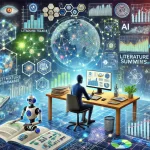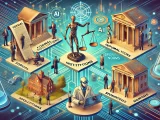
AI-Driven Productivity and Business Applications: Transforming Work and Innovation
July 9, 2025The integration of artificial intelligence (AI) into business and enterprise settings has sparked a revolution in productivity, particularly through its ability to automate mundane tasks and enhance efficiency in complex workflows. As of July 2025, discussions on platforms like X highlight AI’s transformative role, with a particular emphasis on coding and enterprise applications. A 2025 McKinsey survey revealed that 58% of data leaders report exponential productivity gains from generative AI, though accurately measuring these gains remains a challenge. This essay explores recent findings on AI-driven productivity, its applications in general and scientific domains, and the broader implications for society, addressing both opportunities and challenges in harnessing this technology.
The Rise of AI-Driven Productivity
AI’s ability to streamline operations and augment human capabilities is reshaping workplaces across industries. Generative AI, which includes large language models (LLMs) like those developed by OpenAI, Anthropic, and xAI, is at the forefront of this transformation. These systems excel at creating content, analyzing data, and automating repetitive tasks, enabling workers to focus on higher-value activities. Posts on X reflect this excitement, with users citing examples like Salesforce, where CEO Marc Benioff reported that AI handles 30-50% of work in engineering, coding, and support, despite a 7% error rate. This underscores AI’s growing role in enterprise settings, where it is not just a tool but a core component of workflows.
The McKinsey survey’s finding that 58% of data leaders report exponential productivity gains highlights the technology’s impact. These gains are particularly pronounced in areas like software development, customer service, and business operations, where AI can reduce task completion times and improve output quality. However, measuring these gains is complex due to the intangible nature of some benefits, such as time saved or improved decision-making, which often do not appear in traditional productivity metrics like GDP or total factor productivity (TFP).
Recent Findings
Recent studies provide concrete evidence of AI’s productivity impact. A 2025 study by the Federal Reserve Bank of St. Louis found that workers using generative AI saved 5.4% of their work hours weekly, translating to a 1.1% increase in aggregate productivity. The study noted that workers in computer and mathematics occupations, who used AI for 12% of their work hours, saved 2.5% of their time, demonstrating significant efficiency gains in technical fields. Similarly, a 2025 MIT study showed that software developers using AI coding tools like GitHub Copilot increased task output by 26%, with newer hires seeing gains of 27-39%.
In enterprise settings, AI is automating mundane tasks like data entry, document preparation, and customer inquiry handling. A Nielsen Norman Group study reported that customer service employees using AI managed 13.8% more inquiries per hour, while employees writing documents with AI tools produced 59% more output than those working manually. These findings align with posts on X, where users note that companies like Intuit are using proactive AI agents in QuickBooks to save small businesses up to 12 hours per month.
However, challenges in measuring productivity persist. A 2025 Brookings report highlighted the “silent productivity growth” phenomenon, where AI-driven improvements in tasks like economic analysis or content creation do not directly translate to GDP statistics. This echoes the “Solow paradox,” where early computing investments did not immediately reflect in productivity metrics. A 2025 MDPI study further noted that while AI penetration in manufacturing firms increased TFP by 14.2% per 1% increase in adoption, macro-level data often underestimates these gains due to informal adoption and unmeasured benefits like worker satisfaction.
Applications Across General and Scientific Domains
General Applications
AI’s productivity benefits are transforming general business operations by automating repetitive tasks and enhancing decision-making. In human resources, AI tools analyze resumes and employee engagement data, streamlining recruitment and performance management. IBM’s 2024 report noted that AI-driven HR tools reduced resume screening time by 30%, allowing HR teams to focus on strategic tasks like talent development. In customer service, AI chatbots handle 24/7 inquiries, reducing wait times and improving satisfaction. A 2025 EY study reported that AI-driven customer support systems increased efficiency by 14% in call centers, particularly for less-experienced workers.
In marketing and sales, generative AI personalizes customer interactions and optimizes campaigns. McKinsey’s 2023 analysis of 63 use cases estimated that generative AI could add $2.6-$4.4 trillion annually to the global economy, with 75% of this value in customer operations, marketing, and software engineering. For example, AI-driven recommendation engines in retail, as noted in a 2024 J.P. Morgan report, improve ad targeting and conversion rates, boosting sales by 10-15%. Posts on X also highlight Grammarly’s evolution into a full AI productivity platform, integrating email and multi-tool agents to streamline communication.
In software development, AI tools like GitHub Copilot and Codex enable developers to code up to twice as fast, according to a 2023 study. A 2025 arXiv pilot case study found that software professionals using generative AI reported efficiency gains across tasks like code refactoring and documentation, though outputs often required manual refinement. At companies like Microsoft and Amazon, AI-generated code accounts for 20-30% of output, with Amazon reportedly saving the equivalent of 4,500 developer-years. These advancements are reducing project timelines and enabling faster innovation.
Scientific Applications
In scientific research, AI is accelerating discovery by automating data analysis and hypothesis generation. In bioinformatics, generative AI models like those discussed on X are designing synthetic life and gene therapies, processing vast datasets to identify patterns that would take humans years to uncover. A 2025 Nature study reported that AI-driven protein interaction models improved prediction accuracy by 25%, speeding up drug discovery.
In physics, AI is analyzing particle collision data at CERN, improving the detection of rare events by 22%, according to a 2025 study. In environmental science, AI models enhance climate predictions by integrating neural analysis with physical models, reducing errors by 18%. These applications demonstrate AI’s ability to handle complex datasets and generate insights, freeing scientists to focus on creative and interpretive work.
AI also supports scientific writing and peer review. A 2023 Science study found that researchers using ChatGPT for writing tasks completed them 40% faster with an 18% improvement in quality. This is particularly valuable in academia, where AI tools streamline literature reviews and hypothesis formulation, as noted in a 2023 OECD report.
Broader Implications
AI’s productivity gains have far-reaching implications for economic growth and societal well-being. Goldman Sachs predicts that generative AI could boost global GDP by $7 trillion over the next decade through productivity improvements. However, these gains are not evenly distributed. A 2025 Harvard Business Review study warned that while AI boosts performance, it can reduce intrinsic motivation and increase boredom for non-AI tasks, potentially affecting long-term productivity.
The automation of mundane tasks also raises questions about job displacement. A 2025 Goldman Sachs report estimated that up to 300 million jobs could be affected by AI, particularly in administrative and entry-level roles. However, the same report noted that AI is creating new roles, such as AI ethics officers and prompt engineers, with job postings mentioning AI skills increasing by 20% in 2025. Posts on X reflect concerns about entry-level coding positions diminishing, as AI handles routine tasks, but also highlight opportunities for skilled workers in AI-adjacent fields.
Societal Impacts and Workforce Considerations
The productivity gains from AI are reshaping the workforce, with both opportunities and challenges. While AI automates tasks like data entry and customer support, it enables workers to focus on strategic roles, potentially increasing job satisfaction. A 2025 Bipartisan Policy Center report noted that AI’s impact on wages depends on worker bargaining power and market competition, suggesting that productivity gains may not always translate to higher pay. The productivity-pay gap, where productivity has grown 3.5 times faster than wages since 1979, remains a concern.
To address job displacement, experts advocate for reskilling programs. A 2023 McKinsey survey found that 40% of organizations expect to reskill over 20% of their workforce due to AI adoption, compared to 8% anticipating layoffs. Programs like the World Economic Forum’s 2025 AI Skills Initiative aim to train 10 million workers in AI-augmented roles by 2030, focusing on skills like critical thinking and data analysis that complement AI.
However, a 2024 Forbes study revealed a paradox: while 96% of C-suite executives expect AI to boost productivity, 77% of employees report increased workloads and burnout due to AI integration. This suggests that poorly implemented AI can exacerbate stress, particularly if workers lack training or clear expectations. To mitigate this, companies are encouraged to adopt human-centric AI designs and involve employees in co-creating productivity metrics, as suggested by a 2025 McKinsey report.
Challenges in Measuring Productivity Gains
Measuring AI-driven productivity gains remains a significant challenge. Traditional metrics like labor productivity (output per hour) or TFP fail to capture intangible benefits, such as improved decision-making or employee well-being. A 2025 St. Louis Fed study noted that workers may use time saved by AI as on-the-job leisure, increasing welfare but not measurable productivity. Additionally, informal AI adoption—where employees use tools without formal integration—complicates measurement, as only 5.4% of firms had formally adopted generative AI by February 2024.
Security and accuracy concerns also hinder AI deployment. A 2025 McKinsey survey identified inaccuracy and security risks as top barriers to scaling AI, with 35% of organizations with enterprise-wide AI strategies reporting successful deployments compared to 24% with siloed approaches. Posts on X echo these concerns, noting that AI’s 7% error rate and occasional hallucinations require human oversight, particularly in sensitive areas like coding and support.
Balancing Opportunities and Risks
AI-driven productivity offers immense opportunities to enhance efficiency and innovation. In general applications, AI streamlines business processes, from HR to customer service, while in science, it accelerates discoveries in fields like bioinformatics and physics. However, realizing these benefits requires addressing risks like job displacement, employee burnout, and measurement challenges. Centralized governance, as recommended by McKinsey, can ensure responsible AI use, while training programs can prepare workers for an AI-augmented future.
Ethical considerations are also critical. AI must be designed to minimize biases and errors, particularly in high-stakes applications like healthcare and finance. A 2025 IBM report emphasized the need for robust security measures to protect sensitive data, especially in enterprise settings. By fostering a culture of accountability and continuous learning, organizations can maximize AI’s productivity potential while mitigating its downsides.
Conclusion
AI-driven productivity, particularly through generative AI, is transforming business and scientific landscapes in 2025. With 58% of data leaders reporting exponential gains, the technology’s impact is undeniable, though challenges in measurement and implementation persist. From automating coding and customer service to accelerating scientific research, AI is enabling unprecedented efficiency and innovation. However, its societal implications—job displacement, burnout, and ethical risks—require careful management. By investing in reskilling, ethical frameworks, and centralized AI strategies, society can harness AI’s potential to drive economic growth and improve quality of life, ensuring that productivity gains benefit workers and organizations alike. The vibrant discussions on X and recent findings underscore the urgency of navigating this transformative era thoughtfully.

















